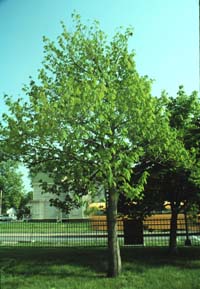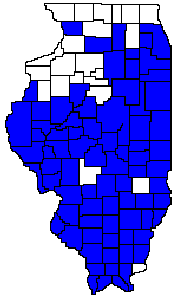 |
| Pawpaw
(Asimina triloba)
Distribution
Map to Right |

Pawpaws are small trees, typically under 40 feet in height, with slender, straight trunks. The trees reproduce less by seed than by root sprouting (clonally) and therefore occur most frequently in thickets or small clumps. Pawpaws occur on rich, moist sites in mainly the central and southern parts of Illinois, although there is limited distribution in all but the northern and some of the northwestern counties.
Interesting
Facts
Pawpaws
are a northern representative of the custard-apple family (Annonaceae).
They tolerate competition and shade very well, and are present in the understory
of rich, moist forests.
Identifying Features
BarkUses
The bark is smooth when young and develops shallow fissures with age. It is brown to grayish-brown and blotched.
Leaves
Pawpaw leaves are alternate, simple, 10 to 12 inches long and up to six inches broad. They are untoothed, oblong and are narrower toward the base. The surface is smooth, light green and the underside paler green. The leaves have a distinctive odor of green bell pepper when crushed.
Flowers
The flowers appear in the spring as the leaves begin to unfold and are at first green, turning deep reddish-purple. The species name, triloba, refers to the calyx (the outer most flower whorl, made up of the sepals), which consists of three triangular-shaped sepals (sepals are the outermost flower part that usually encloses the rest of the bud).
Fruits
Pawpaws produce light green, three to six inch long, fruits with yellow, edible flesh. The fruits ripen in the fall and have and custard-like texture and banana flavor.
Pawpaw fruits are a favorite food of opossums (pawpaw is sometimes referred to as possumhaw), raccoons, foxes, mice, and people.
The wood is light green, coarse grained, weak, and is commercially unimportant. Pawpaw is, however, planted as an ornamental, particularly where clusters of small trees are desired.